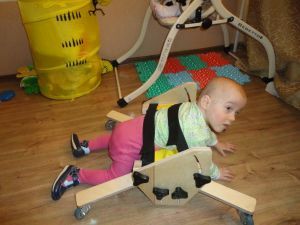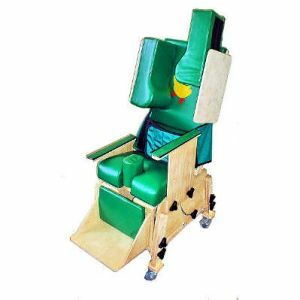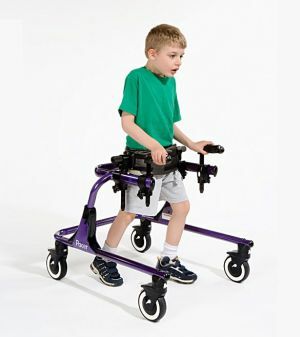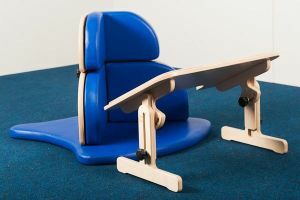 In modern medicine there are no methods for the complete cure of cerebral palsy( cerebral palsy).There are techniques that make it possible to stop the progression of the disease and, as best as possible, prepare the child for adulthood.
In modern medicine there are no methods for the complete cure of cerebral palsy( cerebral palsy).There are techniques that make it possible to stop the progression of the disease and, as best as possible, prepare the child for adulthood.
To this end, the efforts of doctors and close relatives of the child are combined with cerebral palsy, which are helped and invented special supports for standing, sitting, crawling and even lying.
They teach the child to perform the right movements and keep the postures that are important factors on the way to recovery.
Contents
- Why use these tools
- How to use these tools
- Functionality and technical features of
- Types of rehabilitation devices
- Devices for mobility
- Devices for development
- For hygiene
- How to choose
- Everyday use of
- Neurologist word
- Parent thoughts
- Price of attachments
Why do you need these attachments
Supports are selectedfor each patient individually, depending on the severity of the disease and the age of the patient. Adaptations are different: just a chair and a table, chair-chair with equipment, stroller for movement.
They are designed:
- for training, so that the child with cerebral palsy has developed the skills of normal position of the trunk;

- development of the musculoskeletal system;
- stimulation of the central nervous system to a coordinated work;
- control of excitation and braking processes.
Each training gives the muscles an incentive to a stable physical memory, which is necessary in further rehabilitation.
All orthopedic supports assume increased loads and a change in body position, which leads to an increase in muscle strength, and the muscles and nervous system work in one connection more steadily and in a coordinated manner. The early beginning of such activities with the baby gives a chance for a better cure.
Functional and technical features of
All supports for disabled children are equipped with numerous adjustments that are adjusted to the individual parameters of the baby, depending on age and physical condition.
The characteristics of the products include:
- The height and slope of the footrest - the foot should be horizontal, and the angle of the fold of the legs in the knees is 90 degrees.
- Height and inclination of the backrest - varies with the growth of the child.
- Size of the headrest - fixes the head in a comfortable position for the sick when feeding. Also the movements of the child should be easy and in the right directions.
- seat parameters are selected for each child to change the body posture.
- The position of the armrests - gives support for the trunk.
- The position of the interdepartmental wedge - called the abductor - develops the normal position of the thighs.
These adjustments are standard and meet all orthopedic requirements. The first adjustment is done under the supervision of the attending physician. Adaptations for seats have standard sizes, it is possible to change only adjustments parameters:
- height - 36-58 cm;
- width - 27-36 cm;
- depth - 11-38 cm;
- overall dimensions - 76h37h90 cm, depending on the size of the parameters.
Types of rehabilitation devices
For the rehabilitation of patients with cerebral palsy, various types of adaptations are produced, which are divided into groups depending on the purpose.
Devices for mobility
The following devices are used: 
- Walkers - are assigned to children who can walk independently, but do not keep their balance. It is a frame on four supports, on wheels, straps-clamps are attached to it and there is a parking brake. The child is placed inside the frame and can walk forward and sideways without the risk of tipping over. It helps in the development of balance when walking.
- Wheelchair - is intended for a child who does not know how to walk alone. It helps him to move around the house and the street. The stroller is equipped with: a backrest capable of changing the angle of inclination;belts that support the patient by the shoulders and waist;support for the head and side supports;abductor. The stroller is usually run by an assistant, but modern models with large rear wheels give the child a chance to drive the stroller himself if he has a developed motor skills.
- Seats - necessary for the child to sit properly. All models of seats have safety belts and an abductor. There are models of armchairs that help the child to change the pose, while training the muscles of the legs. Many models have a table in the set.
Devices for the development of
These include:
- Simulators are all devices that require the child to manifest activity. A popular simulator is the
 device in the form of an exercise bike. One of the popular ones is a simulator in which the pedals are spinning from the electric drive, but the child is active at the same time, which leads to strengthening and relaxation of the muscles.
device in the form of an exercise bike. One of the popular ones is a simulator in which the pedals are spinning from the electric drive, but the child is active at the same time, which leads to strengthening and relaxation of the muscles. - The bike is a bicycle with 3 wheels and the steering column is not attached to the pedals( when the steering wheel is turned, the pedals are not rotated).The bicycle is equipped with straps-fixators for the trunk, cuffs for the hands, fastenings for the shins and feet, the handle for pushing. When the kid is not able to control it, then the assistant does it. The pedals must be turned forcibly, but the legs of the baby move with them. This device helps the child develop leg muscles, expand the space, prepare for independent walking.
- Furniture - for a sick child should be an assistant in the adaptation of the space in which it is trained and developed. One of them is a special chair and table. The chair has the necessary fixatives to help the child sit properly. And the table has two options: as a separate object, equipped with a lot of adjustments, suitable for use with any seat and, as part of the verticalizer, behind which the child works standing up.
For hygiene
Necessary:
- Toilet chair - eliminates the parents from carrying the baby from the chair to the toilet. The chair is equipped with a removable sanitary attachment and straps for fixing the child.
- Bath chair - facilitates the bathing of a sick child. The chair is equipped with straps for fixing and has a backrest tilt adjustment so that it is convenient to place the patient during bathing.
How to choose
 To choose the support for a sick child will help the attending physician. For each patient, she is selected individually, and the expert explains what parameters should correspond to the seat supports.
To choose the support for a sick child will help the attending physician. For each patient, she is selected individually, and the expert explains what parameters should correspond to the seat supports.
The model parents choose themselves, depending on the special devices that can support the baby's body in the right position. It is important that the adaptation has the ability to adjust to the individual characteristics and physical condition of the child.
Everyday use of
Use supports and other devices for people with disabilities, depending on what the child is doing at the moment. All supports have their purpose and their use helps in the development, maintenance and rehabilitation of the patient.
For patients with severe form of cerebral palsy, there are special supports for lying down, which help to lay the baby in various therapeutic postures, contributes to the acquisition of primary movement skills, cognitive and tactile sensations.
The device for crawling helps the child to develop the correct stereotype of movement, stimulates the muscles of the humerus, prepares the baby for independent crawling and walking.
Supports for standing help the child to keep his balance in the standing position. It trains and strengthens the legs, preparing them for walking.
Neurologist word
Children with cerebral palsy are born more often - this is inexorable, Russian statistics. Therefore, more companies are opening up to produce special furniture for sick children.
The task of parents is to choose not only a cheap model corresponding to the size of the child, the product should be multifunctional. Among other things, it is important to choose the technical characteristics of the selected support. To do this, consult with doctors and other specialists who observe your child.
It is not superfluous to carry out the adjustment of all the characteristics, coordinating them with specialists. They will help to adjust the height and distance so that the child is not only comfortable, but he himself was able to carry out some possible movements for his condition - this is the basis for further development and possible recovery of motor activity.
Stanislav Obodin, Moscow, neurologist
Thoughts of parents
We have a large child, weighing 40 kg and a height of 150 cm. We bought a stroller - it is comfortable to use, the child is comfortable in it. All have adjusted for their parameters and now walk with pleasure, and at home skates. It's good that all the covers are removable, can be washed.
Svetlana, Saratov
Recently purchased the rehabilitation chair "Dinosaur", very satisfied with the purchase. Ordered through the online store, it came quickly. My daughter got used to the chair, now we can work with her, train, and it was convenient to feed her. We like.
Anna, Nizhnevartovsk
Price of devices
Prices for supports for patients with cerebral palsy of domestic production are much lower than similar analogues of imported production. Supports for  seats can be purchased at a price of 10 to 25 thousand rubles.
seats can be purchased at a price of 10 to 25 thousand rubles.
Rehabilitation chairs stand a little higher, in the range of 27-29 thousand rubles. Walkers of domestic production can be bought from 8 thousand rubles. Carriages for sick children cost from 55 thousand rubles, if made at Russian enterprises.
Supports for sick children are needed. They help them to develop and adapt to life in the conditions in which they find themselves. This is a great help in caring for a sick child for parents. They help the child to learn space, and to learn the world.


